NVIDIA GeForce GTX 670 Review Feat. EVGA: Bringing GK104 Down To $400
by Ryan Smith on May 10, 2012 9:00 AM ESTOC: Power, Temperature, & Noise
Our final task is our look at GTX 670’s overclocking capabilities. Based on what we’ve seen thus far with GTX 670, it looks like NVIDIA is binning chips based on functional units rather than clockspeeds. As a result GTX 670 could have quite a bit of overclocking potential, albeit one still limited by the lack of voltage control.
| GeForce 600 Series Overclocking | |||||
| GTX 670 | EVGA GTX 670SC | GTX 680 | |||
| Shipping Core Clock | 915MHz | 967MHz | 1006MHz | ||
| Shipping Max Boost Clock | 1084MHz | 1188MHz | 1110MHz | ||
| Shipping Memory Clock | 6GHz | 6GHz | 6GHz | ||
| Shipping Max Boost Voltage | 1.175v | 1.162v | 1.175v | ||
| Overclock Core Clock | 1065MHz | 1042MHz | 1106MHz | ||
| Overclock Max Boost Clock | 1234MHz | 1263MHz | 1210MHz | ||
| Overclock Memory Clock | 6.9GHz | 6.6GHz | 6.5GHz | ||
| Overclock Max Boost Voltage | 1.175v | 1.162v | 1.175v | ||
Because of the wider gap between base clock and boost clock on the GTX 670 we see that it doesn’t overclock quite as far as GTX 680 from a base clock perspective, but from the perspective of the maximum boost clock we’ve slightly exceeded the GTX 680. Depending on where a game lands against NVIDIA’s power targets this can either mean that an overclocked GTX 670 is faster or slower than an overclocked GTX 680, but at the same time it means that overclocking potential is clearly there.
We’re also seeing another strong memory overclock out of a GK104 card here. GTX 680 only hit 6.5GHz while GTX 690 could hit 7GHz. GTX 670 is only a bit weaker at 6.9GHz, indicating that even with the relatively small PCB that NVIDIA can still exceed the high memory clocks they were shooting for. At the same time however this is a luck of the draw matter.
The EVGA card meanwhile fares both worse and better. Its gap between the base clock and and maximum boost clock is even larger than the reference GTX 670, leading to it having an even lower overclocked base clock but a higher overclocked maximum boost clock. The real limiting factor however is that it couldn’t reach a memory overclock quite as high as the reference GTX 670 – again, luck of the draw – which means it can’t match the overclocked reference GTX 670 as it’s going to be more memory bandwidth starved more often.
Moving on to our performance charts, we’re going to once again start with power, temperature, and noise, before moving on to gaming performance. We’ll be testing our GTX 670 cards at both stock clocks with the maximum power target of 122% (170W) to showcase what is possible at validated clockspeeds with a higher power cap, and a true overclock with a maximum power target along with the largest clock offsets we can achieve.
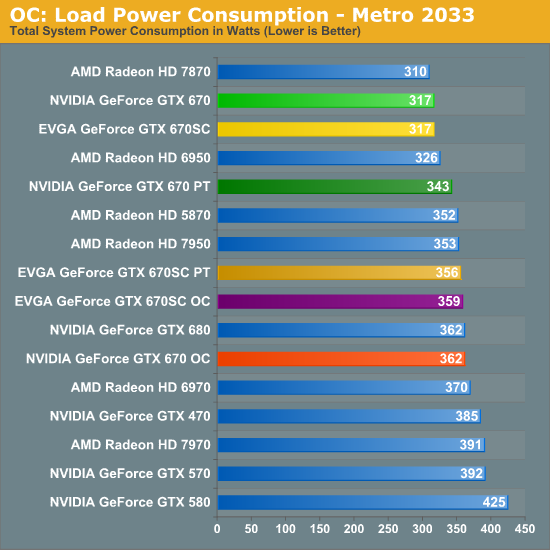
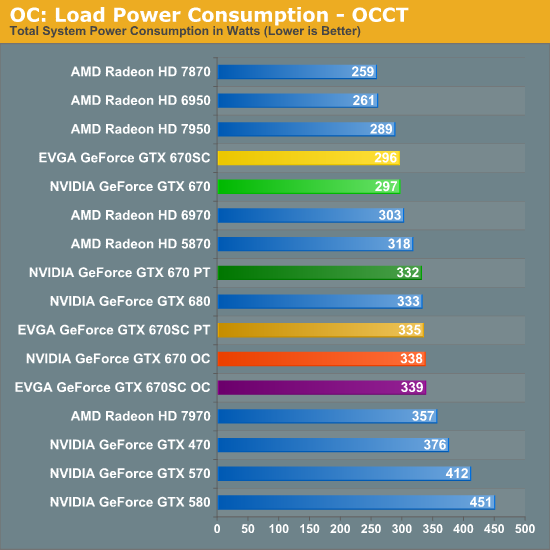
Not surprisingly, since we’re almost always operating within the realm of the power target as opposed to the TDP on the GTX 600 series, our power consumption closely follows our chosen power target. Cranking up the power target on the GTX 670 for example to 170W puts us within 6W of the GTX 680, which itself had a 170W power target in the first place. This is true for both Metro and OCCT, which means power consumption is very predictable when doing any kind of overclocking.
This also means that power consumption is still 18W-30W below the 7970, which in turn means that if these overclocks can close the performance gap, then the GTX 670 still has a power consumption advantage.
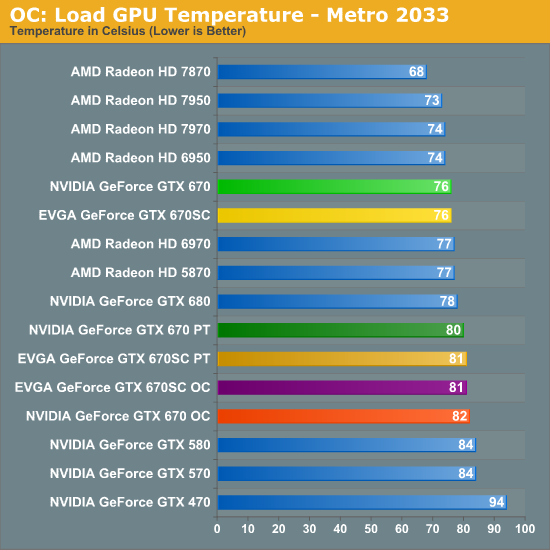
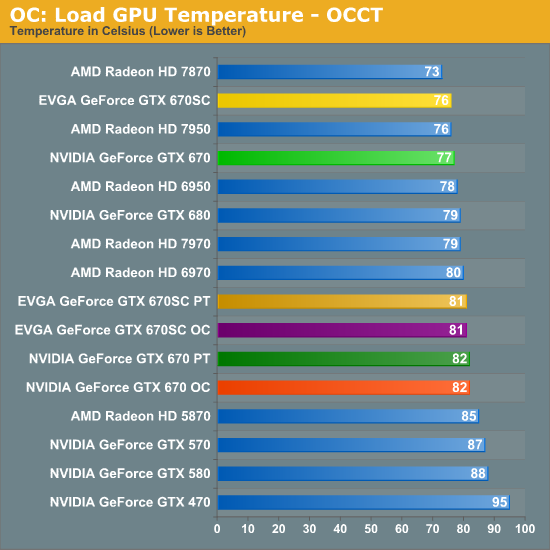
As to be expected, with an increase in power consumption comes an increase in load temperatures. However the fact that we’re only able to increase power consumption by about 30W means the temperature rise is limited to 4-5C, pushing temperatures into the low 80s. This does end up being warmer than the equivalent GTX 680 however due to the 680’s superior heatsink.
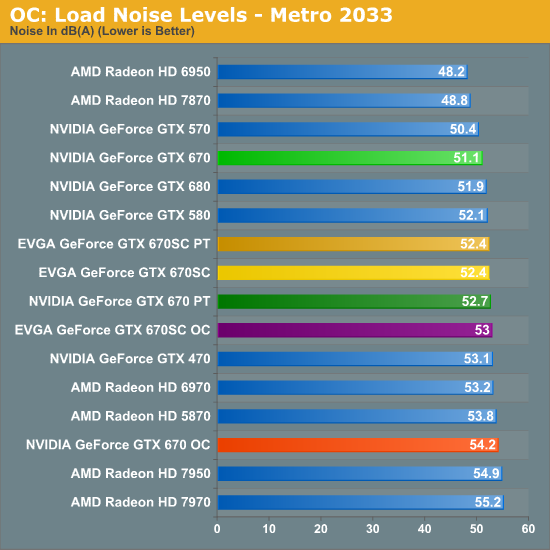

Finally, when it comes to noise we’re also seeing the expected increase, but again it’s rather small. Under Metro the amount of noise from the reference GTX 670 rises by under 3dB when pushing the power target higher on its own, while it rises 3dB when adding in our full overclock. Again the smaller cooler means that the GTX 670’s fan has to work harder here, which means our gaming performance may be able to reach the GTX 680, but our noise is going to slightly exceed it. As a point of reference, in the process we’ll also exceed the GTX 580’s noise levels under Metro. Still, in both OCCT and Metro none of our GTX 670 cards exceed the Radeon HD 7900 series, which means we've managed to increase our performance relative to those cards without breaching the level of noise they generate in the first place.










414 Comments
View All Comments
Morg. - Thursday, May 10, 2012 - link
No.I am saying that tahiti XT paired with 384 bits RAM AND clocked at the same speed as a gtx 680 paired with 256 bits RAM, has clearly more raw power.
The thing is, two years from now, nVidia will be boosting other new games for the NEW nVidia hardware and you will not benefit from it on the old H/W.
However, raw power will remain, 3GB of RAM will still be 3GB of RAM and you will thank god for the added graphics you get out of that last 1 GB that cost you nothing more.
The two games that have for years been GPU benchmarks and haven't been sponsored by either nVidia or AMD are Crysis warhead and metro 2033.
If you wanna trash those results because BF3 is everything to you, you should totally do it though.
scook9 - Thursday, May 10, 2012 - link
Crysis: Warhead is a "The way it is meant to be played" title.....You see that every time you start it up as well as on the box.
http://image.com.com/gamespot/images/bigboxshots/3...
eddman - Thursday, May 10, 2012 - link
Two years from now 7970 won't be powerful enough anyway.As scook9 mentioned, warhead is an TWIMTBP and yet runs better on 7970.
It'd be better if you removed that tin foil hat. TWIMTBP and Gaming Evolved are programs to help developers code their games better.
There are countless TWIMTBP games that run better on radeons.
Crysis and warhead use an old engine that isn't going to be used anymore. Nowadays they are just obsolete benchmarks.
Metro 2033 is a very nice game and I really liked it, but it's not that popular and has a proprietary engine. Most gamers don't care about such engine.
Frostbite, OTOH, matters because it belongs to a major publisher/developer which means we'll see many games based on it in the future.
SlyNine - Thursday, May 10, 2012 - link
I'm pretty sure a 4870 (basically a 6770) is powerful enough today, why wouldn't a 7970 be powerful enough by than.Just because an engine is going to be used anymore doesn't mean it isn't useful to gauge certain aspects of a videocard. Many engines that will be used are not even developed yet, some may push a card more like the Crytech engine did.
Crytech 2 is going to be used for MechWarrior online baby. (Im glad it used a good engine, and it looks like they are using it to good effect).
eddman - Thursday, May 10, 2012 - link
Because 3GB memory is for high-resolutions and high AA settings, and 2 years from now 7970 won't have enough power to run those games at those settings at good frame rates.That doesn't make sense. Card A might run max payne 1 twice as fast as card B, but what'd be the point.
No, mechwarrior online uses cryengine 3, not 2. Cryengine 2, that was used in crysis and warhead, is dead.
SlyNine - Saturday, May 12, 2012 - link
I meant CryEngine 3. not sure why I said 2.There is no proof that 3gigs wont be enough for high res by then. Yea maybe not (or maybe) with AA.
Besides you didn't say anything about running maxed out everything, you made a blanket statement that the 7970 wont powerful enough period.
That means that card A does something that card B cannot, depending on what that is it have an effect on engines that focus on certain things.
eddman - Saturday, May 12, 2012 - link
I meant 7970 won't have enough shader power 2 years from now, so 3GB won't help then either.Yes, everything maxed out with high AA. After all that's what large memories are for.
Obsolete engine is obsolete. Deal with it. Cryengine 2 won't be used in any other AAA game. It's gone.
SlyNine - Saturday, May 12, 2012 - link
A realtime engine will always tell you something about the card. Obsolete or not.If 3GB gives it some sort of advantage then it was worth it. In many games it's already showing an advantage at ultra high res.
Only you are saying the only use of large video cache is AA at ultra settings. But this is simply a questionable premise.
I really don't care if Cryengine 2 is used for a AAA game, or ever again. I still play Crysis. Furthermore I don't give a dam about AAA games, most of them are dumbed down for mass appeal.
CeriseCogburn - Monday, June 11, 2012 - link
At 7000X what rez is 3GB showing an advantage ?ROFL - desperation
theprodigalrebel - Thursday, May 10, 2012 - link
BF3 has sold 1.9 million copies worldwide.Metro 2033 has sold 0.16m copies worldwide
Crysis is an old game that I don't see (m)any people playing.
BF3 is also scheduled for three DLC releases (two this year, third next year).
I see a perfectly good reason why BF3 performance matters. You are speculating that the 7900-series will have great Unreal 4 performance. That's just silly since nobody knows anything about Unreal 4 performance yet.
The only thing I could find was Hexus.net reporting that nVidia chose the Kepler to demonstrate the Unreal 4 engine at the GDC.